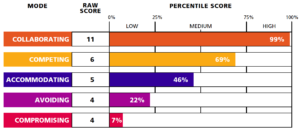27 Apr Using Raw Scores versus Percentiles for Reviewing Your TKI Results
Ralph H. Kilmann, co-author of the Thomas-Kilmann Instrument (TKI)
When Ken Thomas and I first used raw scores in the early 1970s, people would always ask us: “What does each score mean? How do I score compared to others? Do these scores tell me what I should be doing differently?”
The use of percentiles developed as ONE way to answer these questions. We arbitrarily defined the top 25% as using a mode more often than others (in the same norm group) and the low 25% as using a mode less often than others. Because there was a different distribution of those percentiles for each conflict mode, the raw score it took to get into the high or low percentile bracket is different for each conflict mode.

The purpose of the TKI interpretation is “to discover whether you might be overusing (a high score) or underusing (a low score).” We use the term “might” because the appropriate, effective usage of a mode depends on eight key attributes in the situation (including the level of stress, trust, quality of communication and listening skills, importance of the conflict to either person, whether the conflict is complex or simple, whether there is time for discussion, and so forth).
Here is the key: Once you find out that you MIGHT be using a mode too much or too little, you then have to examine the key attributes of a situation to determine if you are ACTUALLY using that mode too much or too little. If, for example, you are facing complex and very important conflicts (to all concerned), have the time, the culture, the skills, etc., to resolve those conflicts, then if you scored high on collaborating, you would NOT be using the mode too much, since it fits or matches the requirements of your situation.
If you ONLY looked at the percentiles of high and low, but you ignored the important aspect of whether your high or low modes are actually needed in YOUR situation, then I suppose the percentiles do not make much sense per se. But using the TKI percentiles to INITIALLY focus attention on which modes are possibly being used too much or too little is a good way to start exploring how to improve conflict-handling behavior in a particular situation. As such, I would much rather use percentiles than the raw scores to begin that conversation. Otherwise, the raw scores have no grounding…as compared to what?
Kilmann Diagnostics offers a series of eleven recorded online courses and nine assessment tools on the four timeless topics: conflict management, change management, consciousness, and transformation. By taking these courses and passing the Final Exams, you can earn your Certification in Conflict and Change Management with the Thomas-Kilmann Instrument (TKI). For the most up-to-date and comprehensive discussion of Dr. Kilmann’s theories and methods, see his 2021 Legacy Book: Creating a Quantum Organization: The Whys & Hows of Implementing Eight Tracks for Long-term success.





